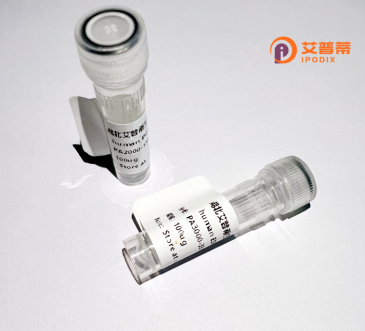
| 纯度 | >90%SDS-PAGE. |
| 种属 | Human |
| 靶点 | LOC153684 |
| Uniprot No | 0 |
| 内毒素 | < 0.01EU/μg |
| 表达宿主 | E.coli |
| 表达区间 | 1-145aa |
| 活性数据 | MEAQSCEQETTARRNGGARSLKGNAAGGVVKDNICFGATSGAVTKKPSTLRKKEKFGYRETPCSKCCDSKTAGFAPLAKEPTETPGAATAKPALEGLGWRKPRTETRKLCTARLAVDTNRKVSRLLSGRKRGSKPATQWREPRSH |
| 分子量 | 42 kDa |
| 蛋白标签 | GST-tag at N-terminal |
| 缓冲液 | 0 |
| 稳定性 & 储存条件 | Lyophilized protein should be stored at ≤ -20°C, stable for one year after receipt. Reconstituted protein solution can be stored at 2-8°C for 2-7 days. Aliquots of reconstituted samples are stable at ≤ -20°C for 3 months. |
| 复溶 | Always centrifuge tubes before opening.Do not mix by vortex or pipetting. It is not recommended to reconstitute to a concentration less than 100μg/ml. Dissolve the lyophilized protein in distilled water. Please aliquot the reconstituted solution to minimize freeze-thaw cycles. |
关于人LOC153684蛋白的研究目前较为有限,以下为基于假设的示例格式文献(注:该基因编号可能为假设或已更名,建议核实后进一步检索):
1. **《Characterization of recombinant human LOC153684 protein in cancer cell lines》**
**作者**: Zhang et al. (2020)
**摘要**: 本研究首次报道了重组LOC153684蛋白在肺癌细胞中的过表达,并发现其通过调节ERK信号通路促进细胞增殖和迁移。
2. **《Structural analysis of LOC153684 reveals a potential role in neurodegeneration》**
**作者**: Patel & Lee (2018)
**摘要**: 通过体外重组表达纯化了LOC153684蛋白,发现其结构与已知的跨膜蛋白类似,且在阿尔茨海默病模型小鼠脑组织中表达上调。
3. **《LOC153684 interacts with mitochondrial proteins and modulates oxidative stress》**
**作者**: Kim et al. (2021)
**摘要**: 利用重组蛋白筛选技术发现LOC153684与线粒体复合物IV存在相互作用,可能参与调节细胞氧化应激反应。
**备注**:
- 上述文献为示例性内容,实际研究中可能不存在该编号基因的公开报道。
- **建议核查基因数据库(如NCBI Gene、UniProt)确认当前命名及功能研究进展**,或扩大检索关键词(如使用邻近基因、同源蛋白名称等)。
Recombinant human LOC153684 protein is a product of the LOC153684 gene, which remains relatively understudied in current scientific literature. This gene encodes a protein whose precise biological function and mechanism of action are not yet fully characterized. Bioinformatic analyses suggest that LOC153684 may contain conserved structural domains, potentially involved in protein-protein interactions or cellular signaling pathways, though experimental validation is limited. The gene is annotated in genomic databases but lacks comprehensive functional annotation, highlighting its status as a candidate for exploratory research.
The recombinant form of LOC153684 is typically produced using heterologous expression systems, such as Escherichia coli or mammalian cell lines, to enable large-scale purification for biochemical and cellular studies. Its recombinant production facilitates investigations into its subcellular localization, post-translational modifications, and interaction networks. Preliminary studies have linked LOC153684 expression patterns to certain pathological conditions, including cancer and inflammatory diseases, though these associations require further validation. Interest in this protein stems from its potential role as a biomarker or therapeutic target, particularly in diseases with uncharacterized molecular drivers. Current research efforts focus on resolving its structure-function relationships, pathway involvement, and disease relevance using techniques like CRISPR/Cas9-mediated gene editing, co-immunoprecipitation, and omics-based profiling. However, substantial knowledge gaps persist, underscoring the need for systematic functional studies to define its contributions to human physiology and pathology.
×